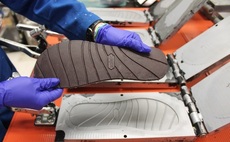
Q&A: Grab's Ming Maa
Ming Maa, president of Grab, explains how the transformation of a taxi-hailing start-up into a diversified technology heavyweight reflects ongoing confidence in Southeast Asia’s economic future
Q: How has Grab developed over 2018?
A: We started the year with a merger with Uber and as result of that, we have more than 130 million downloads on the platform and we're doing just over $1 billion of revenue a year. We're the first technology company to reach that level in Southeast Asia. We now have seven R&D centers around the world, including satellite offices in Beijing, Bangalore, and Seattle, and we've made a dramatic shift in focus by increasing our engineering headcount more than 2x to almost 2,000 people. We also closed about $3 billion in fundraising during the year from a broad set of new investors. We never thought we'd be able to raise that much, but investor appetite for this opportunity set has been tremendous.
Q: What's your view on concerns about rising valuations in Southeast Asia?
A: From a macro perspective, the investment we've received has been a clear sign that the global investment community believes in Southeast Asia and the entire ecosystem of products and services that we're involved in. Those investors look at multiple opportunities in the region and they make decisions on who they believe in, so we let them pick their horses. But at the end of the day, it's the customers who decide a company's value. If the customer sees value in what you're doing, they'll come back. If you no longer provide value, the customers will go. That's why we just stay very focused on execution. We're number-one in every country we operate in. According to a recent study by ABI Research, Grab's market share for ride-sharing in Indonesia is 62%.
Q: What's your outlook for regional consumer markets?
A: Fundamental consumer demand is very strong. You have a vibrant middle class and very young demographics that are entering the part of their earning curve where they become truly prolific spenders. That will create internal consumption right across the region. At the same time, Southeast Asia will largely benefit from global trade issues because both the US and China will be looking for new partners and this is a fairly independent region. The only question is how global trade will affect foreign exchange and whether a strong US dollar will impact purchasing behavior. Still, the macro situation is just amazing. We're talking about an entire generation of consumers, many of whom have never had access to modern banking, leapfrogging out of a cash economy.
Q: This phenomenon has been fueling Grab's operational diversification…
A: Competing with Uber forced us to focus on ride-sharing, but after the merger, we were able to create more services for our customer penetration area, which is one out of every 2-3 smart phone handsets in the region. In the middle of the year, we completely transformed the company into what we call a daily lifestyle platform. That includes everything from food delivery to last-mile logistics for e-commerce packages and launching in a very heavy way into payment services.
Q: What is needed to develop a multi-use app in a market like Southeast Asia?
A: We could develop a daily lifestyle service because the Grab brand is trustable. It's all about the relationships you develop with customers. Ride-sharing helped us do that because we're engaging with consumers every day instead of just once a month like some other online businesses. So, it starts with being a trusted brand, and that's especially important in payments because if you're storing your money in a wallet, you have to know that the service provider will always be there.
Q: Can you describe Grab's approach to financial services?
A: We are the first and only company in technology that has a mobile wallet across all six major ASEAN countries. Next year, we'll be announcing a remittance service for cross-border because there's been a lot of worker travel in the region. In Indonesia, we recently partnered with Tokopedia, which is helping us permeate all the physical retailers with GrabPay. That pervasiveness is important, and we will replicate the strategy across the region. One of our core beliefs is that for payments to succeed, you need to have an ecosystem of partners. If you're not able to use mobile payments in a very broad and pervasive way, then the value is not high enough. Once we refine a service, we can take it across our entire footprint of more than 235 cities. That's for everything we do.
Q: What's your strategy for further expansion in a Southeast Asia context?
A: It's very difficult to scale across this region because it is so diverse. There are 10 different countries, 10 different cultures, and even more languages. We know we can't do everything ourselves, so we launched Grab Ventures this year to work with other entrepreneurs. That provides services to our customer base and helps entrepreneurs accelerate from zero to 130 million customers as quickly as possible. Whether it's payments, geo data, or reinventing user-IDs, these components are missing. We've already built the infrastructure, and now we want to make those services available faster than would be possible with just financial capital investment.
Q: What other areas of tech development are you looking at?
A: We have a vision to electrify the entire transport chain. In Singapore, we're already the largest operator of EVs [electric vehicles]. We've had tremendous support from Hyundai and Kia, which share a similar vision. Together, the goal is to roll out the largest EV fleet in the region. We're doing something different with every one of our strategic investors. For example, Booking Holdings is a leader in travel, hotels and flights, so we're looking at the pain points around transportation and payments when you're in another country and don't speak the language. Also, Microsoft has built out the world's best artificial intelligence and machine learning platform, and we're looking to apply that to better personalize the experience when you use Grab.
Q: What do you see as your main growth areas this year?
A: If 2019 is anything like 2018, we'll see a tremendous amount of opportunity. We'll have the largest food delivery business in the entire region, and we'll further consolidate payments while launching lending pilots focused on credit and micro-credit. In the core transportation business, we'll push toward greater efficiency and reliability via pooling products and better integration with all forms of transport. It's going to be a year of a lot of different products opportunities, particularly with all the strategic partners we have. Today, we're in Singapore, Indonesia, Malaysia, the Philippines, Vietnam and Thailand, and the opportunity in each country is still massive. What's really driving growth for us is layering on more services in those economies.
Latest News
Asian GPs slow implementation of ESG policies - survey
Asia-based private equity firms are assigning more dedicated resources to environment, social, and governance (ESG) programmes, but policy changes have slowed in the past 12 months, in part due to concerns raised internally and by LPs, according to a...
Singapore fintech start-up LXA gets $10m seed round
New Enterprise Associates (NEA) has led a USD 10m seed round for Singapore’s LXA, a financial technology start-up launched by a former Asia senior executive at The Blackstone Group.
India's InCred announces $60m round, claims unicorn status
Indian non-bank lender InCred Financial Services said it has received INR 5bn (USD 60m) at a valuation of at least USD 1bn from unnamed investors including “a global private equity fund.”
Insight leads $50m round for Australia's Roller
Insight Partners has led a USD 50m round for Australia’s Roller, a venue management software provider specializing in family fun parks.







